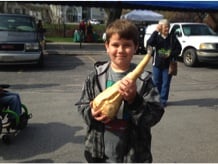Food & Farming / News & Views / Northwest Michigan’s Farm to School Program Thrives
Northwest Michigan’s Farm to School Program Thrives
FoodCorps, 10 Cents program get kids tasting local, healthy food
Farm to School | September 19, 2014 | By Diane Conners
Recent Comments
- Mark Coe: Having had the oppertunity to present at a local school with Meghan and Leanna, supporting the work Food Corps does is a wonderful thing. They provide a learning oppertunity to our children in agricu...
- Linda Hutchinson: Great! Having been raised on a farm, near Arcadia, I wish my dad who was a Farmer's Market regular in the 60's, 70's and 80's, was here to be involved in the "farm to table" and "local food" initiati...
- Dale Scheiern: It is easy to store and enjoy all winter long too!! Take 1 qt. freezer bags, fill to the point they will lay fairly flat ( not rounded) so they stack easily in the freezer. Local fruit all winter lo...
- Sharron May, The May Farm: You are correct if you are referring to industrial monocultures of animal or plant agriculture which are extractive, organic or not. Fortunately there are small farms pioneering more regenerative prac...
- LillyM: I've been fortunate enough to meet and work with Lianna and hope to meet Meghan. Every FoodCorps volunteer I have met over the years has been incredible. A phenomenal organization with dedicated and...
*This article originally appeared on MyNorth.com on Sept. 15, 2014.
In Northern Michigan Kids news, schools across northwest Michigan have been serving up local food experiences in cafeterias, classrooms, and school gardens, and we’ll be sharing some of those stories each month. It’s a concerted effort to get kids excited about eating healthy food. And, wow, does it show. Consider:
 |
| Tyrell and his parsnip. |
Just before school let out last year, Traverse City third-grader Tyrell Stott walked through the downtown farmers market with his mom Judith Ann Stott and spied a root vegetable nearly as big as his torso.
The farmer watched, amazed, as Tyrell headed straight for the largest parsnip on display, exclaiming “Ooooh! Parsnips!” and eagerly asked his mom if he could take it home. His teacher happened to be passing by with her family, and witnessed the exchange. “What are you going to do with that?” she asked him. Without hesitation the student described how he’d prepared it roasted in a classroom lesson: “I’m going to chop it up and cook it. Parsnips are sweet!”
The farmer, Andrea Romeyn of Providence Farm in Antrim County, told the boy’s mom she thought it was “pretty cool” that he knew what a parsnip was and wanted his mom to buy it. “She told me her son’s school gets all the credit.”
The school, in this case, was Traverse Heights Elementary. It’s one of four in the Traverse City Area Public Schools system and 14 region-wide in eight districts that have been participating with the Michigan Land Use Institute’s farm to school education program. That program includes an AmeriCorps program called FoodCorps plus community educators paid with a National Farm to School Grant. The Traverse Bay Area Intermediate School District is working with MLUI and FoodCorps to develop lessons that align with teaching requirements for long-term sustainability. Need to teach fractions? How about cutting an apple into equal parts and then taste-testing different varieties grown by local farmers?
The local FoodCorps has even created a cool voting system, where kids pick a card that best describes their experience with a fruit or vegetable tried in the cafeteria or classroom: “Tried it,” “Liked it,” and “Loved it.”
At Platte River Elementary in the Benzie County Central school system, one student first cast his vote for “liked it” when he tasted kale chips. Then, he came back to try it again and re-cast his vote. He said: “If I double-try it, I love it!” It’s these types of multiple exposures to healthy local food that will make a difference for students, and for school food service efforts to serve it.
The other schools participating in the program are Central Grade, Blair and Interlochen in the TCAPS system; Betsie Valley, Crystal Lake and Lake Ann in the Benzie Central system; and the Frankfort, Northport, Glen Lake, Leland, Suttons Bay and Central Lake elementary schools.
In all, area school children tasted 29 locally grown fruits and vegetables last year:
Apples, apricots, asparagus, beets, blackberries, blueberries, cabbage, carrots, cherries, dry beans, grapes, kale, lettuce, nectarines, onions, parsnips, pears, peas, peppers, plums, potatoes, radishes, raspberries, strawberries, spinach, swiss chard, tomatoes, Romanesco cauliflower, and winter squash.
Each of the eight districts participating in the program also are part of another initiative called 10 Cents a Meal for School Kids & Farms. This project recognizes that schools have tight food budgets, with only 20 to 30 cents a meal to spend on fruits and vegetables. 10 Cents a Mealprovides a maximum match of 10 cents a meal for locally grown fruits and vegetables when schools spend at least 20 cents a meal on local produce. It’s based on one of the recommendations of the Michigan Good Food Charter.
If you like the idea of farm to school in the classroom, cafeteria and garden you can learn more and discuss ways to make these innovative programs sustainable for the long-term. It’s one of the topics at an upcoming event October 10 in Traverse City called Food, Farms & Health. Learn more here.
Keep up on other fun activities at the Farm to School in Northwest Michigan Facebook page.
And if you have a great farm to school story, send it to Diane Conners, Senior Policy Specialist at the Michigan Land Use Institute at diane@mlui.org.






